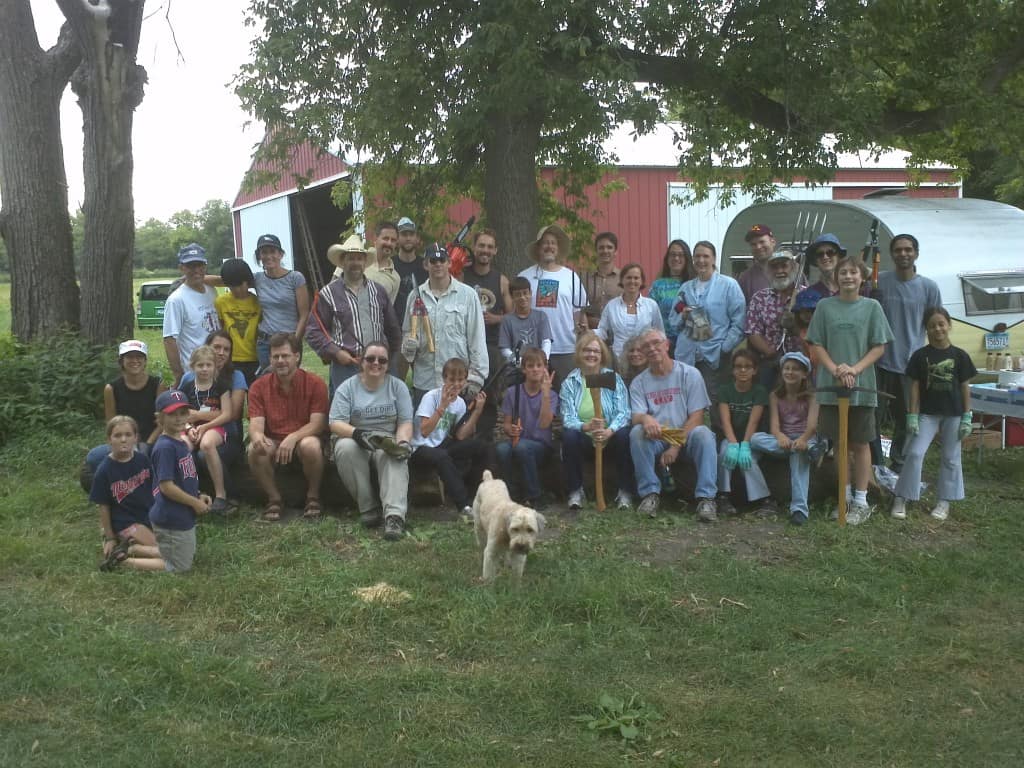Sogn Farm Project
Last night Cannon Falls got 10 inches of rain. The farm took a bit of a beating as you can see from the photos. We lost our culvert completely: a 6-foot diameter corrugated steel pipe was washed 120 yards downstream around an S curve, and a 4-foot diameter 40-foot long culvert wound up at a 45 degree angle, 100 yards downstream. We lost a number a trees and have a cleanup job ahead of us.
Makes me think about resilience in the face of weather extremes. Climate change?
[nggallery id=4]
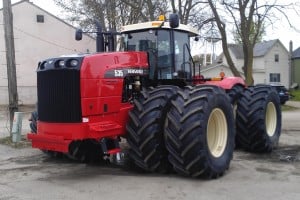
New Tractor at Issacson Implement
Next to a barn, a tractor is probably the most evocative symbol of “farm” in America. When I visited Issacson Implement in Nerstrand the other day (good folks, BTW), I saw this little number. The price, I think, was $280,000. Nearly as much as we paid for our whole farm!
Obviously, it makes no sense for us to buy a tractor like this – and clearly there are tractors more appropriate to our farm – but it does prompt me to think a bit about the nature and scale of different kinds of farms. Nowadays, it’s common for a farmer in Minnesota to ‘run’ 1000 or more acres – some owned, some rented. And many of these farmers – at least around Sogn – seem to be growing mostly corn and soybeans. The number of anhydrous ammonia trailers on the roads earlier this spring suggest that most of what is grown is conventional: i.e. using chemical fertilizers, pesticides and herbicides. These have to be, then, high-dollar operations for which 400hp 4WD tractors are just tools of the trade. Makes quite a contrast to our little farm – and the farms of some of the folks I’m getting to know.
I’ve started to think of various kinds of farms on two axes of a grid: high dollar to low dollar (both investment and cash flow), and low to high diversity (for example, corn and soy rotation versus small farms that do poultry and eggs plus veggies and/or fruits for CSA and/or farmers markets).
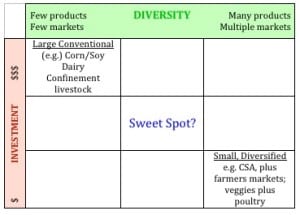 Now, if you want to do a large conventional corn and bean (or dairy, or confinement beef, pork or poultry) operation, you can get lots of help from the University’s Farm Business Management program or the Center for Farm Financial Mangement (e.g. this report). These folks have worked with thousands of farmers over the years and can help design a business plan, or tell you if your costs are too high, production too low, interest expense too high and so on: they can tell you a lot about how to run certain kinds of farm businesses because, in part, they’ve seen lots of other farmers doing almost exactly the same thing.
Now, if you want to do a large conventional corn and bean (or dairy, or confinement beef, pork or poultry) operation, you can get lots of help from the University’s Farm Business Management program or the Center for Farm Financial Mangement (e.g. this report). These folks have worked with thousands of farmers over the years and can help design a business plan, or tell you if your costs are too high, production too low, interest expense too high and so on: they can tell you a lot about how to run certain kinds of farm businesses because, in part, they’ve seen lots of other farmers doing almost exactly the same thing.
But what about your small-scale diversified, sustainable or even organic farm? Where is the business model? How can someone running that sort of operation benchmark their operation or write a business plan? For these folks (and that includes our little farm) I can’t seem to locate any established benchmarks, and there seem to be few people who know the business side well enough to review the operation, business plan etc.
This has at least two important effects. First, small diversified farmers appear to lack some useful tools that could help them run their businesses. Second, these same farmers often lack the information they need to finance their operations – in part because lenders or investors don’t have tools to evaluate a small diversified farm’s business plan.
Now many of the small-scale early-stage farmers I’ve met recently are up to their necks in work already and record keeping and accounting – especially for their complex and diversified operations – are not top priorities. This leads to my query-du-jour: would gathering information about successful medium-sized, somewhat diversified farms (that is, in my suggested ‘sweet spot’, of which examples are rumored to exist in SE Minnesota and likely elsewhere) be a useful first step in establishing models and benchmarks to help farmers, lenders and, potentially, investors better understand and evaluate well-run sustainable farms?
What do you think? Would this be a worthwhile project? Or is this information available somewhere and I’ve overlooked it? Suggestions, comments or advice will be most welcome!
– 0 –
This work-in-progress has benefited from conversations with many wise people. I don’t know if they’d like to see their names here so, for now, I’ll just acknowledge their organizations: The Institute for Agriculture and Trade Policy, The Land Stewardship Project, Moonstone Farm, The First National Bank of Plainview, The Carrot Project, Renewing the Countryside, University of Vermont Extension, Midwest Organic and Sustainable Education Service (MOSES) and Featherstone Farm.
Thank You!
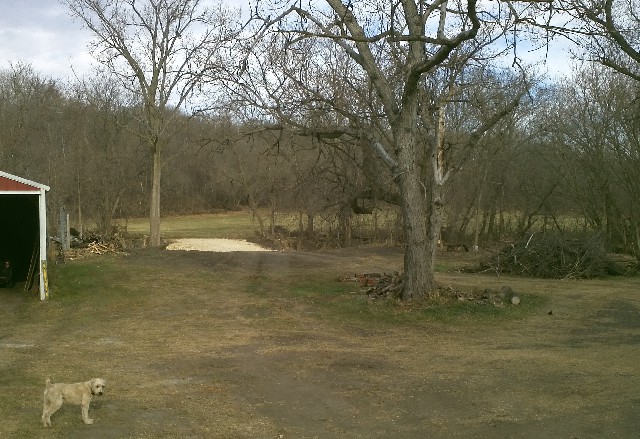
New Culvert, November 2011
This week another milestone in our farm project was passed: the culvert for crossing the creek is now complete. This will make all the difference in the world to the function of the farm as the largest fields and hillside are now easily accessible from the farmyard.
Remember the heaps of rubble? Remember all the fallen trees and logs in the creekbed? Remember the overgrown jungle by the creekside? How about the falling-down pole shed? I do. And I’m grateful for all the effort that went into clearing all that up so the culvert work could be done and . . . just look at it now.
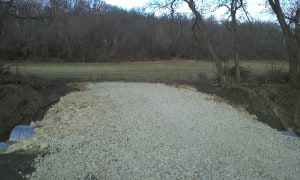
Looking over the culvert, November 2011
As I walked the farm today I felt such gratitude for the amazing community which has helped us bring things so far. While walking, I talked with my farmer friend Kate Stout of North Creek Community Farmwho asked me what was our greatest success this year. I answered that the involvement, connection and fun of bringing together folks from our multiple communities had been the most satisfying part of the whole project – as indeed it has. Thank you to everyone who has made all this progress possible. The building, the culvert, the junk removed, the old barn cleaned and repaired – the list is astonishing.
As Thanksgiving approaches, I many reasons to be thankful including, especially, the unfolding dream of this farm.
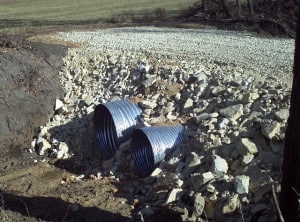
New Culvert – another view
I’m thinking about next year.
If you’ve been down to visit you may have noticed that our tillable acreage naturally falls into four or five fields as you can see in the aerial photo below. At the moment all but the smallest field are in alfalfa – good for organic transition. It’s now been over a year since prohibited chemicals were applied to the land but it will take two more seasons before we can attempt organic certification. We can leave the fields in alfalfa and take several cuttings of hay each year . . .
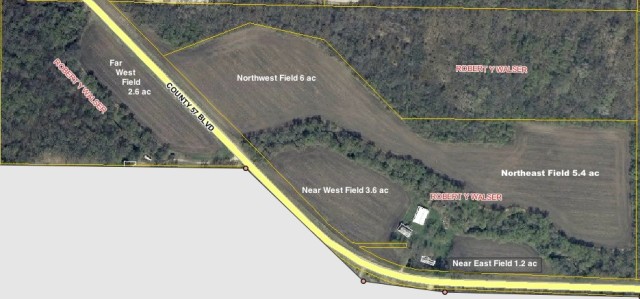
Aerial photo from Goodhue County GIS
. . . or maybe try something [what might that be?] else.
What will the story of this farm be? What can grow beautifully here? In the next few years I’d like to have a number of experiments running on the land: different folks trying particular crops/approaches to see what works well. This year a Hmong farmer grew corn and squash. At the moment there is one person proposing to start a CSA on a portion of the land next year. My neighbor to the north has a vineyard and winery. He wants me to grow hops (and I have to say I’m intrigued by the notion – but it takes a lot of expensive infrastructure). Also on my mind are crops that can be dried for winter use: corn for cornmeal, beans for drying.
The soil is rich and deep with good mineral balance and plenty of organic matter. Should be good for many things (we had a soil test last spring). The tillable portions are identified in the USDA soil survey as Kennebec silt loam, Lindstrom silt loam and McPaul silt loam. You can check it out here (though it takes a few minutes to figure out the system – see below).
So how can we get several projects going? I wonder if there are folks (especially young farmers!) who would like to bring me proposals to take a field or a portion of a field and try something: CSA, hops, small grains, particular veggies – something they really want to do. I can provide the land, access to electricity and water, some on-site storage etc.. I don’t yet have a tractor or equipment, but that may change. With our land and infrastructure and their (your?) ideas and effort perhaps some beautiful thing(s) might grow.
NOTE: To use the USDA system, zoom in to Minnesota, then Goodhue County, then Warsaw township, then the farm by clicking repeatedly on the map – takes me 11 clicks. Once you have the farm filling the window, define an ‘Area of Interest’, AOI using the red polygon AOI tool on the map: click to mark the boundaries, double-click to finish. Then click the “Soil Map” tab on the top and you’ll get the details.
Thanks to Chad and Mike, Emery and Dennis! We have trusses up, a roof, basement stairs and interior walls. With some windows and doors we’ll be able to work on the interior no matter what happens with the weather . . . Up in the woods I’ve nearly completed the snowshoeing/mushroom trail. Also thinking about the next growing season, but more about that in the next post.
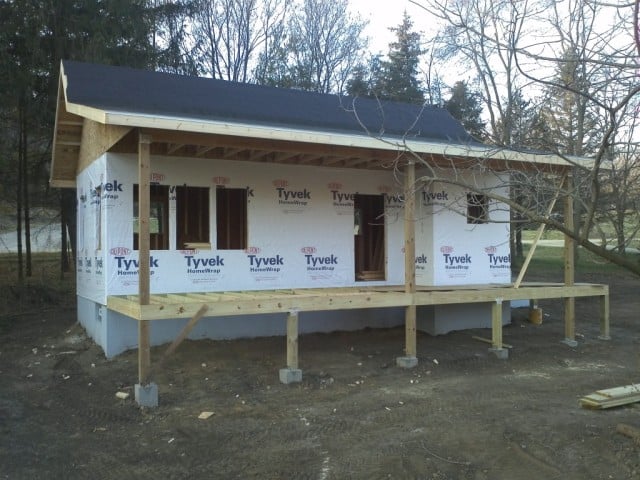
View from the North on 5 November, 2011
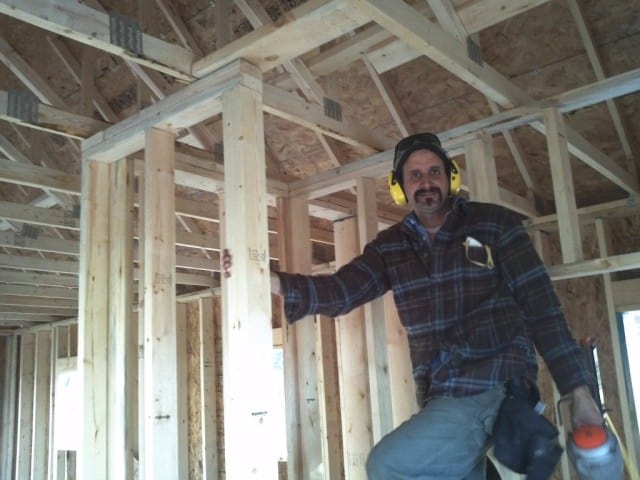
Chad building the interior walls
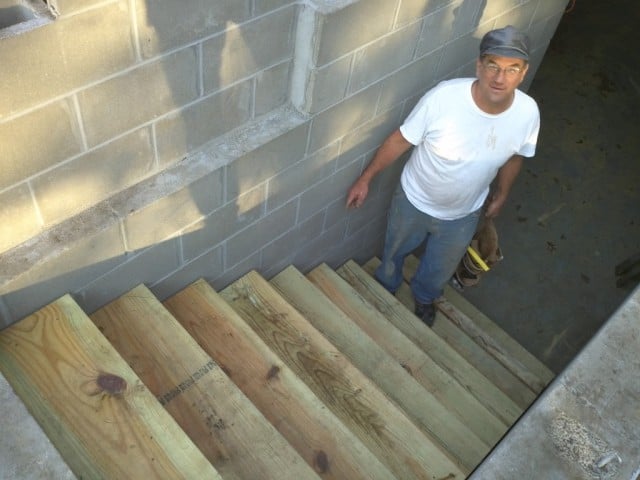
Mike with the cellar stairs.
What an amazing weekend! In a complex two-day dance, folks from multiple communities came together at the farm to build, sheath and raise all the walls for the new farm office.
My heart was near to bursting as I watched people with different levels of skill, experience and physical strength working together in elegant cooperation: encouraging, respectful and playful. While having fun and enjoying friends old and new, I’m guessing a lot of folks learned things about building, wood, tools and more. Special thanks are due to the more experienced framers and carpenters who patiently helped the rest of us make meaningful contributions. The place glowed with a warm spirit that filled my heart – words can’t capture how it felt. I am enormously fortunate to know so many big-hearted folks and to get to share experiences like this.
Thank you, each and every one not only for the hard work and great results, but even more for the inspiring friendship, spirit, generosity, fun and music you brought to the Sogn Valley this weekend.
Big big thanks to John, Chad and Tracey for getting the sill, rim joists, floor joists and subfloor in in just a day. Wow, do I have skilled, hard-working and talented friends (who are darn good company to boot!).
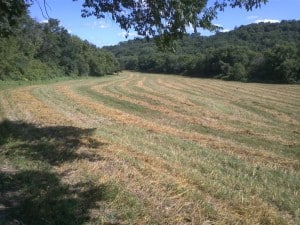
Straw drying on the big field after combining the oats
Time to think about next year. The oats are combined and sold, the straw is in the pole barn (waiting for a customer – anyone need a round bale or 22?) and Tou Pau’s corn is gone though there are still squash and over-ripe cucumbers in his field.
What have I learned so far? The oats/alfalfa plan is a good one for organic transition but not for the long-term: there isn’t enough profit in the crops to pay the rent. The future of this farm needs to include higher value crops – but which ones? I’m intrigued by hops and my grape-growing neighbor is encouraging me, but what else?
I’ve been approached by one individual who’d like to use a portion of the tillable acreage for a CSA. I wonder if anyone else would like to propose something. For next season I need to realize some income from the land but am open to non-cash returns as well. Beyond that whatever happens needs to:
- continue progress towards organic certification and
- add to the knowledge base of the farm: what works, what doesn’t, why?
With 25 tillable acres there is room for more than one project. At the moment I’m thinking that two or three trials might be good with the balance in hay (that’s what the alfalfa’s for).
What are the best next steps for this farm? Pondering . . .
This weekend, everything changed at the farm.
What had been Bob’s project with visits and a little help from family and a few friends began to become part of the life of our communities.
What amazing, generous, talented and hard-working friends we have! Folks from seven to the seventies joined our family at the farm to haul brush, clean out the barn, dig through a miserable trash heap, fill a 20-yard dumpster, do some lumberjacking, move walls and do a million other jobs then have a brew, play some music, enjoy a campfire and eat apples off the trees. If Julie’s count is correct there were 33 adults, 2 teens, 12 kids and 5 dogs.
These friends have blessed this farm and the promise it holds. The vision is still taking shape, but by sharing in the work and fun the whole project begins to find its place in the circles of friendships and communities that so enrich our lives. This is part of the dream: people coming together for work, sure, but for music, fun and connection to each other and the land.
I feel like the luckiest man in the world. Thank you every one.

